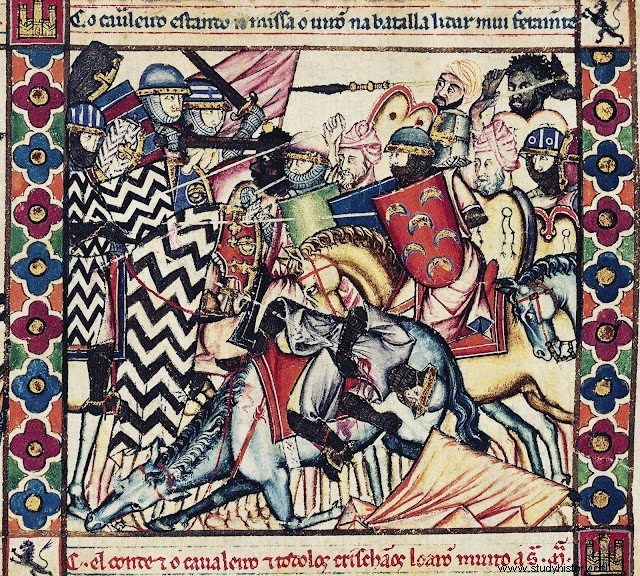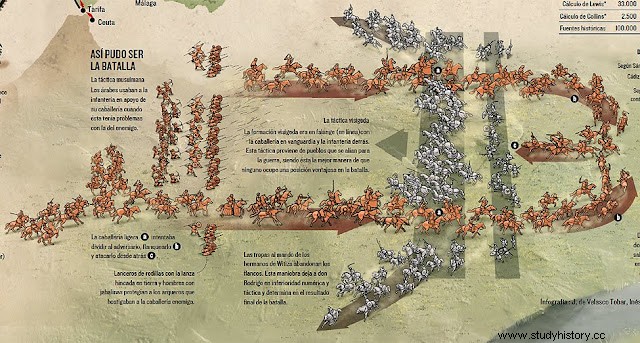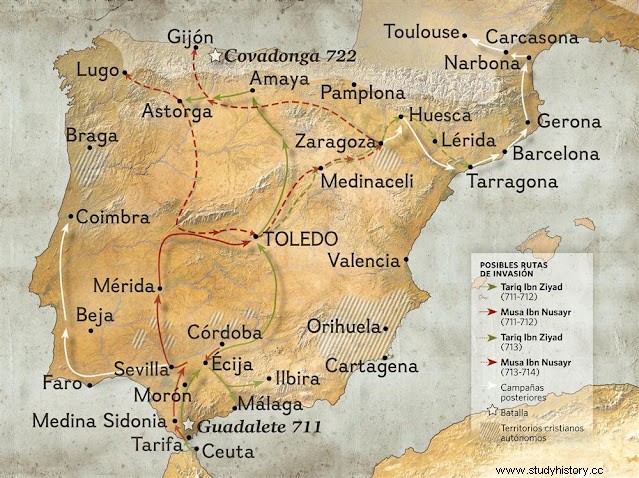" The king's horse was found covered in arrows on the banks of the Guadalete River"
Betrayed and abandoned by his own, King Rodrigo loses control of the peninsula before a powerful army from North Africa. Muslim rule would last more than seven centuries.
 King Don Rodrigo haranguing his troops at the battle of Guadalete,
King Don Rodrigo haranguing his troops at the battle of Guadalete,
In peninsular Spain and Ceuta, the Visigothic empire reigned, which also included Portugal, part of the Mediterranean coast from France to Marseille, known as Septimania. Visigothic Hispania was immersed in a dispute over the throne, which Rodrigo, who had the support of the elite majority of the secular and ecclesiastical aristocracy, wanted to seize, seizing it from Agila II, son of Witiza, the previous king, who possibly would have been overthrown and most likely killed. When Rodrigo was proclaimed Visigothic king, a split was created in the empire. Agila's supporters did not like Rodrigo's proclamation.
The members of the Witizano side, despite their opposition to the appointment of don Rodrigo, dared to swear allegiance to the new monarch while behind his back they conspired to eliminate him, something that would clear the path to the throne. Thus, the main step that the children of Witiza decide to take to end the reign of Don Rodrigo is to meet with the Muslims, who were in full expansion, and to whom the Witizas offered to open the doors of the Peninsula in exchange. your help.
 Cover of The Chronicle of King Rodrigo, which collects the traditions about the last Visigoth king and the loss of Spain .
Cover of The Chronicle of King Rodrigo, which collects the traditions about the last Visigoth king and the loss of Spain .Around the year 710 the Arabs, led by Musa ibn Nusayr, seized Septem (Ceuta), a city under the control of the Empire, governed by a character named Julián, who would play a leading role in the conquest and legend later. The port and the ships of the African coast will allow a military operation in the Peninsula. It was a large-scale operation, since the contingents that cross the Strait are considerable, but not essential, since Musa stays in Africa and delegates command to a subordinate of his named Tariq ibn Ziyad. The Witizanos facilitated the crossing of the Strait of Gibraltar on the night of April 27-28, 711.
The conspirators planned to use the Muslims to do their bloody work for them:to eliminate Don Rodrigo and his his followers, which once achieved they could take advantage of to reach the throne. However, they did not count on the Muslims having their own intentions and they did not realize that instead of being the ones using the Muslims to achieve their goals, they were the ones being used by the Umayyads to further their expansion.
It is very likely that the Umayyad general Táriq landed some 7000 Berber foot soldiers in Tarifa, taking Carteia and later Algeciras, where he repelled the attack of Bancho or Sancho, Rodrigo's nephew who had come out to meet him. Shortly after he received 5,000 reinforcements sent by the caliphate. They numbered 10,000 Berbers and 2,000 Arabs. With the arrival of the Muslims in the Peninsula, the plan of the Witizanos began to take shape.
Battles of Hispania Official Shop
While all this was happening, the Visigoth king was in the north of the Iberian Peninsula fighting the Vascones in Pamplona. The news takes two or three weeks to arrive. The crisis suffered by the Visigothic kingdom in those fateful moments, with continuous collusion and fratricidal wars between the nobility to seize the throne, considerably limited Rodrigo's room for maneuver when it came to recruiting an army with which to face the invasion. , being forced to accept the self-interested help of the Witizanos, whose betrayal he was unaware of. However that may be, he was able to hastily organize an army of 40,000 men in Córdoba and leave to meet Táriq. Modern estimates say that only 2,000 Muslims and 2,500 Visigoths participated in the battle.
Don Rodrigo's main objective was to search for the direct confrontation with Tariq through a decisive battle that would drive him back to the African continent. Battle in which all the flower of the Visigothic nobility appeared. Don Rodrigo and his troops sighted the Muslim camp on July 19, 711, located on a hill next to the Guadalete River and fortified by a palisade. The superiority of the Visigothic troops over the Muslims did not help in a bad battle strategy and in a betrayal by the Witizanos.
The day of the sighting of the camp (July 19) Don Rodrigo decided to launch his attack. This consisted of an uphill cavalry charge directed at the enemy camp, but disrupted by the narrowing of the hill. Being the waves of Muslim arrows the ones in charge of massacring the Visigoths in this first action. The three cavalry charges failed to penetrate Tariq's camp.
 Painting of the Battle of Guadalete
Painting of the Battle of GuadaleteThe next day the fighting continued after a long defeatist night in the Visigoth camp. Where the witizanos dedicated themselves to demoralizing the troops, arguing that the invaders were only looking for loot and that once they filled their pockets they would return to their lands, with which they proposed to their followers to abandon don Rodrigo in the middle of the fight so that the Muslims would finish off him and his men.
In the midst of a battle to the death, the sons of Witiza, who commanded the flanks, separated from the Visigothic army, leaving Rodrigo in numerical and technical inferiority against the Muslims. Apparently, the Berbers, with their light cavalry and their quick and deadly attacks, decimated the surrounded forces loyal to the Gothic monarch after a hard fight. Tariq's attack was devastating, as he almost completely destroyed the Visigoth hosts, seizing victory and plunging the Visigothic world into disaster.
 Development of the battle
Development of the battleIn the battle King Rodrigo was defeated and probably lost his life at the hands of the forces of the Umayyad Caliphate. The king's horse was found covered with arrows on the banks of the Guadalete river, some believed that the king could have escaped but surely his body was dragged by the current; The thing is, he was never heard from again.
The Visigothic defeat left Táriq free to reach Toledo, which was unprotected as King Rodrigo had taken with him a large part of the defense weapons of the royal guard of the city. Toledo did not resist, at the end of the same year 711 it was taken. The defeat was so complete that it marked the end of the Visigothic state in the Iberian Peninsula.
 Muslim advance in the Iberian Peninsula
Muslim advance in the Iberian PeninsulaFar could the conspirators suppose that their request for help to recover the throne in exchange for tributes was going to cost them so dearly and what were the true intentions of conquest of the Arabs. Musa, suspicious of Tariq's successes, decided to personally intervene in 712, commanding an army of 18,000 men, mostly Arabs. His goal was to reestablish the legitimate authority that only belonged to him as governor of Ifriquiya-Maghreb. The expedition, whose goal was Toledo, starts in Algeciras and continues through Carmona, Seville and Mérida until, in the Toledan region, Tariq and Musa join forces and continue the occupation of the Ebro Valley, Asturias and Galicia without encountering hardly any resistance. .
The defeat at Guadalete meant the loss of almost the entire peninsular territory in favor of the Muslims, leaving the mountainous regions of the north of the peninsula as the only foci of Christian resistance, from where the future Reconquest spread, which cost in around seven centuries conclude.
| Date | Sometime between July 19 and July 26, 711 (traditional date) | |||
|---|---|---|---|---|
| Place | Discussed (Cádiz) | |||
| Coordinates |  36°36′00″N 6°13′00″OCoordinates: 36°36′00″N 6°13′00″OCoordinates: 36°36′00″N 6°13′00″W (map) 36°36′00″N 6°13′00″W (map) | |||
| Result | Decisive victory of the Umayyad Caliphate | |||
| Belligerents | ||||
| ||||
| Commanders | ||||
| ||||
| Forces in combat | ||||
| ||||

 Umayyad Caliphate
Umayyad Caliphate